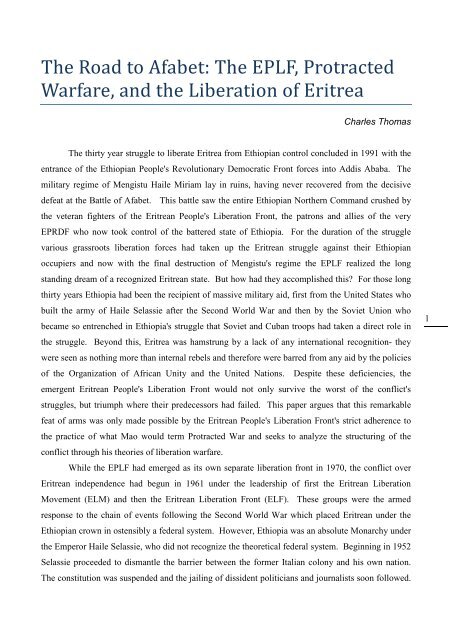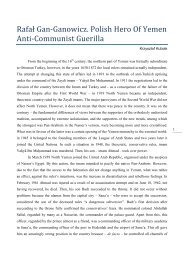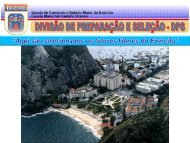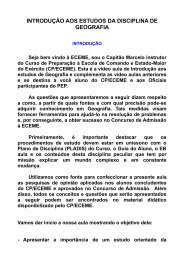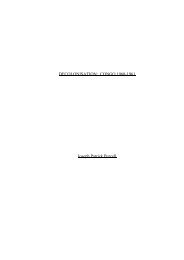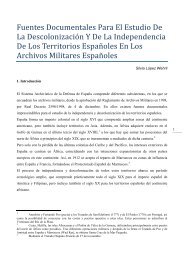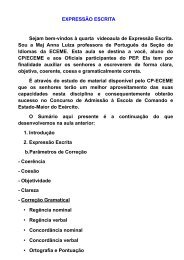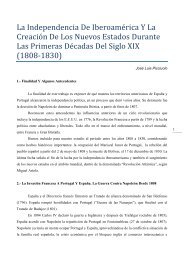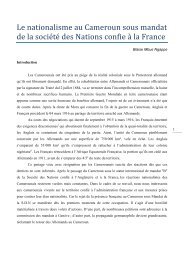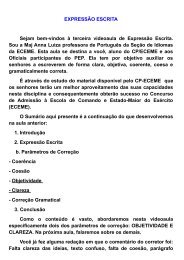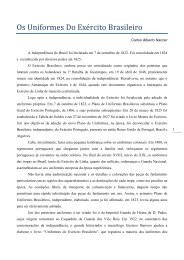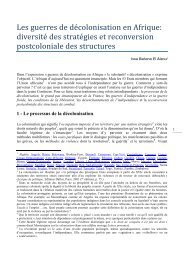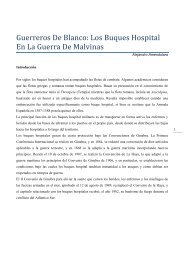34- The Road to Afabet The EPLF, Protracted Warfare, and the ...
34- The Road to Afabet The EPLF, Protracted Warfare, and the ...
34- The Road to Afabet The EPLF, Protracted Warfare, and the ...
You also want an ePaper? Increase the reach of your titles
YUMPU automatically turns print PDFs into web optimized ePapers that Google loves.
<strong>The</strong> <strong>Road</strong> <strong>to</strong> <strong>Afabet</strong>: <strong>The</strong> <strong>EPLF</strong>, <strong>Protracted</strong><strong>Warfare</strong>, <strong>and</strong> <strong>the</strong> Liberation of EritreaCharles Thomas<strong>The</strong> thirty year struggle <strong>to</strong> liberate Eritrea from Ethiopian control concluded in 1991 with <strong>the</strong>entrance of <strong>the</strong> Ethiopian People's Revolutionary Democratic Front forces in<strong>to</strong> Addis Ababa. <strong>The</strong>military regime of Mengistu Haile Miriam lay in ruins, having never recovered from <strong>the</strong> decisivedefeat at <strong>the</strong> Battle of <strong>Afabet</strong>. This battle saw <strong>the</strong> entire Ethiopian Nor<strong>the</strong>rn Comm<strong>and</strong> crushed by<strong>the</strong> veteran fighters of <strong>the</strong> Eritrean People's Liberation Front, <strong>the</strong> patrons <strong>and</strong> allies of <strong>the</strong> veryEPRDF who now <strong>to</strong>ok control of <strong>the</strong> battered state of Ethiopia. For <strong>the</strong> duration of <strong>the</strong> strugglevarious grassroots liberation forces had taken up <strong>the</strong> Eritrean struggle against <strong>the</strong>ir Ethiopianoccupiers <strong>and</strong> now with <strong>the</strong> final destruction of Mengistu's regime <strong>the</strong> <strong>EPLF</strong> realized <strong>the</strong> longst<strong>and</strong>ing dream of a recognized Eritrean state. But how had <strong>the</strong>y accomplished this? For those longthirty years Ethiopia had been <strong>the</strong> recipient of massive military aid, first from <strong>the</strong> United States whobuilt <strong>the</strong> army of Haile Selassie after <strong>the</strong> Second World War <strong>and</strong> <strong>the</strong>n by <strong>the</strong> Soviet Union whobecame so entrenched in Ethiopia's struggle that Soviet <strong>and</strong> Cuban troops had taken a direct role in<strong>the</strong> struggle. Beyond this, Eritrea was hamstrung by a lack of any international recognition- <strong>the</strong>ywere seen as nothing more than internal rebels <strong>and</strong> <strong>the</strong>refore were barred from any aid by <strong>the</strong> policiesof <strong>the</strong> Organization of African Unity <strong>and</strong> <strong>the</strong> United Nations. Despite <strong>the</strong>se deficiencies, <strong>the</strong>emergent Eritrean People's Liberation Front would not only survive <strong>the</strong> worst of <strong>the</strong> conflict'sstruggles, but triumph where <strong>the</strong>ir predecessors had failed. This paper argues that this remarkablefeat of arms was only made possible by <strong>the</strong> Eritrean People's Liberation Front's strict adherence <strong>to</strong><strong>the</strong> practice of what Mao would term <strong>Protracted</strong> War <strong>and</strong> seeks <strong>to</strong> analyze <strong>the</strong> structuring of <strong>the</strong>conflict through his <strong>the</strong>ories of liberation warfare.While <strong>the</strong> <strong>EPLF</strong> had emerged as its own separate liberation front in 1970, <strong>the</strong> conflict overEritrean independence had begun in 1961 under <strong>the</strong> leadership of first <strong>the</strong> Eritrean LiberationMovement (ELM) <strong>and</strong> <strong>the</strong>n <strong>the</strong> Eritrean Liberation Front (ELF). <strong>The</strong>se groups were <strong>the</strong> armedresponse <strong>to</strong> <strong>the</strong> chain of events following <strong>the</strong> Second World War which placed Eritrean under <strong>the</strong>Ethiopian crown in ostensibly a federal system. However, Ethiopia was an absolute Monarchy under<strong>the</strong> Emperor Haile Selassie, who did not recognize <strong>the</strong> <strong>the</strong>oretical federal system. Beginning in 1952Selassie proceeded <strong>to</strong> dismantle <strong>the</strong> barrier between <strong>the</strong> former Italian colony <strong>and</strong> his own nation.<strong>The</strong> constitution was suspended <strong>and</strong> <strong>the</strong> jailing of dissident politicians <strong>and</strong> journalists soon followed.1
In 1956 Amharic was made <strong>the</strong> official language over <strong>the</strong> protests of <strong>the</strong> majority of <strong>the</strong> nation whichhad traditionally adopted Tigrinya or Arabic as <strong>the</strong>ir preferred languages. i That same year <strong>the</strong>Assembly was “Temporarily Suspended.” Although elections followed <strong>the</strong>y were without directionor organization, leading <strong>to</strong> bitterly contested results. <strong>The</strong> nascent Labor Union movement that hadbeen growing in strength <strong>and</strong> organization was essentially driven from sight by a series of crushingblows dealt <strong>to</strong> it by <strong>the</strong> Federal military during protest strikes in 1958. ii This was followed in 1959by <strong>the</strong> leaders of <strong>the</strong> Assembly voting <strong>to</strong> replace <strong>the</strong>ir own penal code with that of Ethiopia after oneof <strong>the</strong>ir increasingly common visits <strong>to</strong> Addis Ababa, Selassie's capi<strong>to</strong>l. By 1960 <strong>the</strong> main politicalsupports of a separate Eritrea had been dissolved, with most governmental <strong>and</strong> grassrootsorganizations having been reduced <strong>to</strong> irrelevancy or driven from <strong>the</strong> country. Even protests directedat <strong>the</strong> United Nations, which had created <strong>the</strong> rapidly crumbling federal system, were simply met with<strong>the</strong> response that all protests would have <strong>to</strong> pass through <strong>the</strong> federal government first- in this case <strong>the</strong>Emperor himself. iii <strong>The</strong> final curtain fell in 1962, when <strong>the</strong> Assembly was at last “persuaded” <strong>to</strong> voteitself out of existence, a process aided by armed police <strong>and</strong> jets providing air cover. Eritrea wasofficially no more as of November 14 th , 1962. iv<strong>The</strong> shooting war had already started in 1961 under <strong>the</strong> auspices of <strong>the</strong> absentee leadership of<strong>the</strong> ELM, which was quickly subsumed by <strong>the</strong> more radical <strong>and</strong> active ELF. Both began <strong>the</strong> policyof characterizing <strong>the</strong> conflict as a struggle against an African colonizer <strong>and</strong> <strong>the</strong>refore <strong>the</strong>ir war wasone of decolonization <strong>and</strong> liberation. However, despite <strong>the</strong>se claims, little progress was madedomestically or internationally. Guerrilla strikes <strong>and</strong> assassinations were carried out, but <strong>the</strong>Ethiopian military carried out a reign of terror that stifled most major operations. This was aided by<strong>the</strong> massive military aid <strong>the</strong> Ethiopian forces received from <strong>the</strong> United States. From 1960 onAmerica's military aid <strong>to</strong> Haile Selassie's forces was staggering, with $10 million dollars a year ingrants <strong>and</strong> loans being offered <strong>and</strong> from 1964 on material <strong>and</strong> logistical support continued <strong>to</strong> arrive. vThis made <strong>the</strong> struggle all <strong>the</strong> harder on <strong>the</strong> Eritrean guerrillas <strong>and</strong> <strong>the</strong> Ethiopian strategy continued<strong>to</strong> evolve <strong>to</strong> incorporate <strong>the</strong> massive advantages <strong>the</strong>y accrued in armor, air superiority, <strong>and</strong> specialcounter-insurgency forces. <strong>The</strong> struggle became even grimmer for <strong>the</strong> ELF as <strong>the</strong> Ethiopian forcesslowly recognized <strong>the</strong> influence of <strong>the</strong> Algerian FLN on <strong>the</strong> ELF's strategic thinking, where <strong>the</strong>Eritrean rebels had divided <strong>the</strong>ir front in<strong>to</strong> five semi-au<strong>to</strong>nomous zones under <strong>the</strong> control of localleaders. vi While in <strong>the</strong>ory this gave a certain amount of tactical flexibility, it instead gave <strong>the</strong>Ethiopian forces a chance <strong>to</strong> target <strong>the</strong> zones one by one while fractious central comm<strong>and</strong> meant thatlittle concerted aid was forthcoming. By 1970 <strong>the</strong> comm<strong>and</strong>ers of three of <strong>the</strong> zones protested <strong>the</strong>structure <strong>and</strong> after a period of attempted negotiation <strong>and</strong> finally violence, split off <strong>to</strong> form <strong>the</strong>Eritrean People's Liberation Front (<strong>EPLF</strong>).2
This split of <strong>the</strong> armed forces would not be <strong>the</strong> last but was certainly <strong>the</strong> most important of<strong>the</strong> conflict. <strong>The</strong> literature since <strong>the</strong> independence of Eritrea has followed various paths <strong>to</strong> analyze<strong>the</strong> reasons behind <strong>the</strong> divergent characters of <strong>the</strong> ELF <strong>and</strong> <strong>the</strong> <strong>EPLF</strong>, covering aspects of religions,ethnicity, class, even economic backgrounds of <strong>the</strong> various member groups, but perhaps <strong>the</strong> simplestexplanation is that of a rising tide of student recruits in <strong>the</strong> late 1960s brought with <strong>the</strong>m newerradical ideas that had been absent in <strong>the</strong> earlier leadership of <strong>the</strong> ELF. <strong>The</strong>se progressivephilosophies were brought <strong>to</strong> <strong>the</strong> fore as <strong>the</strong>se students assumed leadership positions <strong>and</strong> participatedin overseas training courses in such revolutionary countries as Cuba <strong>and</strong> China. By 1970 <strong>the</strong> risingambitions of <strong>the</strong>se younger aspiring leaders <strong>and</strong> <strong>the</strong> faltering grip of <strong>the</strong> older conservativeleadership simply could no longer coexist <strong>and</strong> <strong>the</strong> split occurred. <strong>The</strong> ELF remained a fiercelynationalist but loosely disciplined group of guerrillas <strong>and</strong> older intellectuals while <strong>the</strong> <strong>EPLF</strong> <strong>to</strong>ok amore rigorously revolutionary tack <strong>and</strong> began organizing a disciplined peasant base from which <strong>to</strong>grow its infrastructure. This revolutionary tack, inspired by <strong>the</strong> movements of Mao, Giap, <strong>and</strong>Castro, would lead <strong>the</strong> <strong>EPLF</strong> <strong>to</strong> greater success throughout <strong>the</strong> conflict <strong>and</strong> it would eventually bothoutlast its rival organization <strong>and</strong> achieve its ultimate goals.<strong>The</strong> first major step in <strong>the</strong> alteration of <strong>the</strong> conflict was <strong>the</strong> <strong>EPLF</strong>'s efforts <strong>to</strong> restructureEritrean society <strong>to</strong> successfully wage a People's War. <strong>The</strong> successful <strong>Protracted</strong> Wars in China <strong>and</strong>Vietnam both relied on <strong>the</strong> social transformation of <strong>the</strong>ir states <strong>to</strong> both enhance nationalconsciousness of <strong>the</strong> struggle <strong>and</strong> <strong>to</strong> create a logistical base that would support <strong>the</strong> war efforts of <strong>the</strong>liberation forces. To effect this social change, <strong>the</strong> <strong>EPLF</strong> created a transformative social program <strong>and</strong>a national ideal for <strong>the</strong> emergent Eritrean consciousness. By building off a base of five major massorganizations (for workers, peasants, women, students, <strong>and</strong> youth) which began <strong>to</strong> operate openly in1977 after years of cl<strong>and</strong>estine organizing, <strong>the</strong> <strong>EPLF</strong> enunciated a completely transformativeprogram which would alter <strong>the</strong> very fabric of Eritrean society. This program’s stated goals wouldcompletely rebuild Eritrea in terms of agricultural production, industrial production, education,health care, <strong>and</strong> even gender relations.In terms of agricultural production <strong>and</strong> relations, <strong>the</strong> Eritrean general program for reformcalled for a socialized agricultural sec<strong>to</strong>r with control placed back in <strong>the</strong> h<strong>and</strong>s of <strong>the</strong> producers. In<strong>the</strong>ory <strong>the</strong> program claimed its goals as including <strong>the</strong> nationalization of <strong>the</strong> l<strong>and</strong>s expropriated by <strong>the</strong>Ethiopians <strong>and</strong> <strong>the</strong>ir feudal collabora<strong>to</strong>rs <strong>and</strong> revising this in<strong>to</strong> larger collective farms for <strong>the</strong> use of<strong>the</strong> masses. It also sought <strong>to</strong> introduce more modern farming methods, including <strong>the</strong> use ofmachinery <strong>and</strong> modern fertilizers <strong>to</strong> help increase <strong>the</strong> productivity of <strong>the</strong> peasant class. For <strong>the</strong> stillexisting pas<strong>to</strong>ralists, veterinary <strong>and</strong> breeding aid would be provided as well as financial aid <strong>to</strong> help<strong>the</strong>m become sedentary <strong>and</strong> successful animal breeders. Beyond all <strong>the</strong>se (<strong>and</strong> several o<strong>the</strong>r small3
provisions) it purported <strong>to</strong> allow for <strong>the</strong> amicable <strong>and</strong> fair resolution of l<strong>and</strong> inequality <strong>and</strong>ownership disputes while providing for <strong>the</strong> organization <strong>and</strong> collectivization of peasants so <strong>the</strong>y maylook after <strong>the</strong>ir own affairs. vii For <strong>the</strong> most part <strong>the</strong>se goals were reached. Self-sustaining cells ofpeasant organizers set up village committees that represented all strata of agricultural life. In suchmodel villages as Zagher <strong>the</strong>y oversaw <strong>the</strong> redistribution of l<strong>and</strong> that had been monopolized byricher farming families <strong>and</strong> settled disputes within <strong>the</strong> community. viii While this was a long process,by <strong>the</strong> end of it large numbers of peasants that had never had l<strong>and</strong> of <strong>the</strong>ir own <strong>to</strong> work had plots <strong>to</strong>produce with. Often surplus l<strong>and</strong> could <strong>the</strong>n be farmed collectively by <strong>the</strong> newly set up farmersassociation, <strong>the</strong> produce of which <strong>the</strong>n went in<strong>to</strong> a cooperative shop. <strong>The</strong> individual plots as wellwere allocated along <strong>the</strong> lines of <strong>the</strong> association membership, which organized <strong>the</strong>m in such a way soas <strong>to</strong> allow <strong>the</strong> easier introduction of new farming techniques. <strong>The</strong> front even trained “barefootveterinarians” along <strong>the</strong> lines of China’s famous barefoot doc<strong>to</strong>rs <strong>to</strong> offer free veterinary services <strong>to</strong><strong>the</strong> pas<strong>to</strong>ral <strong>and</strong> agricultural population’s animals.Similar alterations were made <strong>to</strong> <strong>the</strong> structure of industrial production <strong>and</strong> relations. Muchlike <strong>the</strong> Ethiopian- <strong>and</strong> collabora<strong>to</strong>r- owned l<strong>and</strong>, <strong>the</strong> industries held by <strong>the</strong>se proscribed groupswould be nationalized along with <strong>the</strong> vital large industries of <strong>the</strong> nation itself, such as <strong>the</strong> ports,mines, public transport, <strong>and</strong> power. Meanwhile foreign owned industries of a small scale would beallowed as long as <strong>the</strong> owners were from nations that had not opposed Eritrean independence. ix Toaid growth in <strong>the</strong> industrial sec<strong>to</strong>r, urban l<strong>and</strong> would be made state property along with excess urbanhousing. <strong>The</strong> rent for this housing would <strong>the</strong>n be set at a reasonable level for <strong>the</strong> st<strong>and</strong>ard of livingin <strong>the</strong> region by <strong>the</strong> managing government. <strong>The</strong> citizens whose property was thus nationalizedwould be duly compensated for <strong>the</strong>ir losses. x In terms of <strong>the</strong> workers <strong>the</strong>mselves, <strong>the</strong>ir rights were <strong>to</strong>be strictly safeguarded, partially by <strong>the</strong> organization <strong>and</strong> politicization of <strong>the</strong> workers <strong>the</strong>mselves.<strong>The</strong>se stated rights included an eight hour workday <strong>and</strong> at maximum a six day work week as well associal security nets for age <strong>and</strong> disability. <strong>The</strong> nationalized urban property would be made available<strong>to</strong> <strong>the</strong>se organized workers <strong>to</strong> assure <strong>the</strong>m decent living conditions. Most tellingly, <strong>the</strong> politicizedworkers would be given <strong>the</strong> right <strong>to</strong> “participate in <strong>the</strong> management <strong>and</strong> administration of enterprises<strong>and</strong> industries.” xi By offering <strong>the</strong> workers organizations, security, <strong>and</strong> strong interest in <strong>the</strong>continuation of <strong>the</strong> national industries, <strong>the</strong> <strong>EPLF</strong> <strong>the</strong>oretically offered a complete revolution <strong>to</strong> <strong>the</strong>working class. Again, much like <strong>the</strong> agricultural reforms, <strong>the</strong> <strong>EPLF</strong> were able <strong>to</strong> implement <strong>the</strong> vastmajority of <strong>the</strong>se while <strong>the</strong> struggle was still going on. During <strong>the</strong>ir administration of Keren in 1977<strong>the</strong>y retained <strong>the</strong> status of <strong>the</strong> previously nationalized housing but slashed <strong>the</strong> price of <strong>the</strong> rents,particularly <strong>the</strong> lowest rents <strong>to</strong> fur<strong>the</strong>r aid those distressed by <strong>the</strong> conflict. xii <strong>The</strong>y also changed <strong>the</strong>pay scale for workers, lowering those that were highest while dramatically increasing those that had4
een lowest. xiii As <strong>to</strong> <strong>the</strong> industries <strong>the</strong>mselves, even as early as 1975-76 <strong>the</strong> <strong>EPLF</strong> liberated zoneshad a plurality of small cottage industries sustained by <strong>and</strong> sustaining <strong>the</strong> revolution. Woodworkingcollectives altered weaponry while machine shops fabricated parts for everything from weaponry <strong>to</strong>genera<strong>to</strong>rs <strong>and</strong> agricultural machinery. <strong>The</strong>se small front-run workshops were acknowledged <strong>to</strong> be<strong>the</strong> future of <strong>the</strong> nation: “<strong>The</strong>se small shops are going <strong>to</strong> be <strong>the</strong> base for <strong>the</strong> new Eritrea.” xiv <strong>The</strong>collective work, reform, <strong>and</strong> politicization of <strong>the</strong> industrial base of <strong>the</strong> revolution played a vital rolein <strong>the</strong> conflict.In every sec<strong>to</strong>r <strong>the</strong> greatest emphasis was placed on education. Free compulsory education,grants <strong>and</strong> scholarships, <strong>the</strong> establishment of more primary schools <strong>and</strong> institutes of highereducation, <strong>and</strong> most importantly <strong>the</strong> pledge <strong>to</strong> “Combat illiteracy <strong>to</strong> free <strong>the</strong> Eritrean people from <strong>the</strong>darkness of ignorance” xv were central <strong>to</strong> <strong>the</strong> educational revolution that <strong>the</strong> <strong>EPLF</strong> insisted on for<strong>the</strong>ir nation. While it might be thought that most of <strong>the</strong>se goals could only effectively be pursued inpeacetime, perhaps more than any o<strong>the</strong>r sec<strong>to</strong>r of its Revolution <strong>the</strong> <strong>EPLF</strong> made education aubiqui<strong>to</strong>us part of <strong>the</strong>ir struggle. <strong>The</strong> <strong>EPLF</strong> dem<strong>and</strong>ed that all members serving in <strong>the</strong> front beliterate in Arabic or Tingrinya <strong>and</strong> established this training for <strong>the</strong> both <strong>the</strong> older members <strong>and</strong> <strong>the</strong>‘Vanguards,’ <strong>the</strong> youth that were inducted in<strong>to</strong> <strong>the</strong> struggle initially in non-combatant roles until <strong>the</strong>yreached of age. <strong>The</strong>se new inductees were also given educations in his<strong>to</strong>ry, political <strong>the</strong>ory, first aid<strong>and</strong> public health, <strong>and</strong> o<strong>the</strong>r basic subjects. In <strong>the</strong> <strong>EPLF</strong> run refugee camps <strong>and</strong> liberated <strong>to</strong>wnsclasses were given in political <strong>the</strong>ory, <strong>the</strong> his<strong>to</strong>ry of Eritrea, <strong>and</strong> most of all literacy. <strong>The</strong>se sameliteracy courses were run out of <strong>the</strong> hospitals for those rehabilitating from injuries, as well as coursesin geography, <strong>and</strong> elementary math. xvi As<strong>to</strong>nishingly <strong>the</strong>se same sorts of courses were also provided<strong>to</strong> Ethiopian prisoners-of-war, <strong>the</strong> vast majority of which were illiterate conscripted peasants.Beyond <strong>the</strong> training in <strong>the</strong> field, <strong>the</strong> <strong>EPLF</strong> established <strong>and</strong> ran over 36 schools in 1976 alone. xviiWhile it cannot be said that <strong>the</strong> education was given for entirely selfless reasons, as a cynicalobserver can easily claim that such education is better labeled indoctrination, it cannot be denied that<strong>the</strong> mass teaching of literacy altered <strong>the</strong> entire philosophical base of <strong>the</strong> nation <strong>and</strong> helped spread <strong>the</strong>conception of Eritrea as more than a collection of nine separate nationalities.H<strong>and</strong> in h<strong>and</strong> with education was <strong>the</strong> complete overhaul of public health services. <strong>The</strong> <strong>EPLF</strong>sought <strong>to</strong> establish a system of free public health care that not only treated <strong>the</strong> populace at large, butserved as a basis for locally manufactured medicines <strong>and</strong> as centers for <strong>the</strong> eradication of contagiousdiseases. xviii Public health was paramount. In this, as like in much else of <strong>the</strong>ir goals, <strong>the</strong>y maderemarkable headway. Two tiers of medical training (a basic <strong>and</strong> an intermediate) were established <strong>to</strong>produce a greater amount of qualified medical personnel <strong>to</strong> man <strong>the</strong> exp<strong>and</strong>ing programs as <strong>the</strong>movement gained maturity. As of 1977 alone <strong>the</strong> <strong>EPLF</strong> was operating four major hospitals with a5
combined capacity of nearly 1400 patients. xix <strong>The</strong>se facilities were equipped with basic medicalnecessities such as microscopes, refrigera<strong>to</strong>rs, <strong>and</strong> X-ray machines. Beyond <strong>the</strong>se central hospitals,<strong>the</strong> front operated over 20 intermediate clinics established in liberated or semi-liberated areas <strong>to</strong> dealwith regional patients <strong>and</strong> even had limited inpatient capabilities. To supplement <strong>the</strong>se formalfacilities, teams of doc<strong>to</strong>rs were trained <strong>to</strong> travel <strong>the</strong> largely rural areas in <strong>the</strong> mold of <strong>the</strong> “BarefootDoc<strong>to</strong>rs” <strong>to</strong> inoculate <strong>the</strong> populace as well as offer free medical care <strong>to</strong> <strong>the</strong> villages. Over <strong>the</strong> courseof <strong>the</strong>ir struggle <strong>the</strong> <strong>EPLF</strong> extended medical services <strong>to</strong> <strong>the</strong> populace at large where <strong>the</strong>re had beenessentially no formal health services previously.Lastly, <strong>and</strong> perhaps <strong>the</strong> most radical step taken in <strong>the</strong>ir social revolutionary program, <strong>the</strong><strong>EPLF</strong> obliterated <strong>the</strong> previous conceptions of gender roles in <strong>the</strong>ir liberated areas. Whereas Eritreahad long been an extremely conservative <strong>and</strong> patriarchal state regardless of region, <strong>the</strong> <strong>EPLF</strong>explicitly stated <strong>the</strong>ir goals for women’s rights. <strong>The</strong>y were <strong>to</strong> be freed from domestic confinement,be assured full rights of equality in representation, pay, <strong>and</strong> participation, <strong>and</strong> progressive marriage<strong>and</strong> family laws were <strong>to</strong> be established. xx Beyond this <strong>the</strong> <strong>EPLF</strong> promised <strong>to</strong> respect <strong>the</strong> right <strong>to</strong>maternity leave, <strong>to</strong> provide maternal services, <strong>and</strong> even <strong>to</strong> try <strong>and</strong> eradicate prostitution, which <strong>the</strong>yviewed as a violent act against women. It would be right of a commenta<strong>to</strong>r <strong>to</strong> be skeptical though, asit is common for revolutionary movements <strong>to</strong> exalt women’s rights <strong>and</strong> yet do little <strong>to</strong> attain <strong>the</strong>m. xxiHowever, like all o<strong>the</strong>r provisions within its programs, <strong>the</strong> <strong>EPLF</strong> did a remarkable job in attaining itsgoals under <strong>the</strong> pressures of wartime. First <strong>and</strong> foremost, women were organized as an importantpart of <strong>the</strong> front <strong>and</strong> were always given equal representation within <strong>the</strong> political structure of <strong>the</strong><strong>EPLF</strong> itself. <strong>The</strong>y were not barred from serving in any capacity within <strong>the</strong> front <strong>and</strong> womencommonly <strong>to</strong>ok combatant roles, with women constituting 13% of <strong>the</strong> army by 1977. xxii <strong>The</strong>education programs offered by <strong>the</strong> front were perhaps even more revolutionary for <strong>the</strong> womeninvolved, as literacy had been even rarer amongst women than men before <strong>the</strong> conflict. However,<strong>the</strong> alterations <strong>to</strong> women’s rights did not s<strong>to</strong>p within <strong>the</strong> boundaries of direct service <strong>to</strong> <strong>the</strong> front. Inliberated areas <strong>the</strong> l<strong>and</strong> reform was just as open <strong>to</strong> women as men <strong>and</strong> women were amongst thosethat claimed plots of l<strong>and</strong> in Zagher <strong>and</strong> o<strong>the</strong>r model villages. As <strong>the</strong> <strong>EPLF</strong>’s programs becamemore ingrained in<strong>to</strong> <strong>the</strong> social fabric of communities, <strong>the</strong>y often began taking on variations of <strong>the</strong>irmarriage law. This was a revolutionary step, as marriage was a defining characteristic in traditionalEritrean society, where it essentially relegated women <strong>to</strong> a servile role. xxiii With <strong>the</strong> new laws beingput in<strong>to</strong> place, concepts of mutual consent for marriages became common as well as a woman’s right<strong>to</strong> divorce. Beyond this ages of consent began being established, doing away with child-marriageswhich had <strong>the</strong> effect of opening up a whole new world of independent adolescence for youngwomen, transforming <strong>the</strong>ir possibilities in education, employment, <strong>and</strong> even newer ideas of6
courtship. Although this is not <strong>to</strong> say that all communities accepted <strong>the</strong>se changes quickly or easily,<strong>the</strong> balance of sexual power was altered by <strong>the</strong> social revolution of <strong>the</strong> <strong>EPLF</strong> <strong>and</strong> women were <strong>to</strong> agreat degree liberated from <strong>the</strong>ir previous servitude. xxiv<strong>The</strong> social revolution altered Eritrea irrevocably <strong>and</strong> even at <strong>the</strong> time was noted for its farreaching consequences. No less a scholar of revolutions than Gerard Chali<strong>and</strong> wrote “<strong>the</strong> <strong>EPLF</strong> isby far <strong>the</strong> most impressive revolutionary movement produced in Africa in <strong>the</strong> past two decades.”This complete social revolution would prove <strong>to</strong> be vital <strong>to</strong> <strong>the</strong> success of <strong>the</strong> Eritrean struggle for twoprimary reasons. <strong>The</strong> first was that <strong>the</strong> revolution <strong>and</strong> <strong>the</strong> acceptance of its precepts more thananything else helped <strong>the</strong> Eritrean cause overcome <strong>the</strong> regional, linguistic, <strong>and</strong> confessional barriers <strong>to</strong>national unity. While earlier attempts in Eritrea had faltered when regional differences helpedfracture efforts of liberation, following <strong>the</strong> adoption of <strong>the</strong> social revolution <strong>the</strong>re never was acredible threat of ethnic or religious divisions within <strong>the</strong> Eritrean front. By adopting a socialrevolution <strong>and</strong> using it <strong>to</strong> advance precepts that created a national ideology <strong>and</strong> identity which wasaccepted <strong>and</strong> proliferated by <strong>the</strong> populace, <strong>the</strong> <strong>EPLF</strong> created a nation in <strong>the</strong> process of liberating it.<strong>The</strong> second major reason for <strong>the</strong> importance of <strong>the</strong> social revolution has already beendiscussed in a passing manner: <strong>the</strong> creation of loyal <strong>and</strong> productive base areas are a necessity for <strong>the</strong>pursuit of a protracted conflict. By large scale agrarian reform, worker’s rights, women’s rights,education, <strong>and</strong> health care <strong>the</strong> <strong>EPLF</strong> created a popular front that earned <strong>the</strong> peoples’ loyalty <strong>and</strong>efforts. More than this, in <strong>the</strong> model villages <strong>and</strong> <strong>to</strong>wns <strong>and</strong> amongst <strong>the</strong> workshops <strong>and</strong> hospitals in<strong>the</strong> remote regions, <strong>the</strong>y created a popular society that <strong>the</strong>n had a vested interest in seeing <strong>the</strong>irrevolution succeed in <strong>the</strong> only way that mattered: <strong>the</strong> military overthrow of <strong>the</strong> oppressive power.As such <strong>the</strong> <strong>EPLF</strong>’s social revolution created areas that were loyal <strong>and</strong> productive for <strong>the</strong>ir efforts<strong>and</strong> which turned barren for <strong>the</strong>ir opponents. xxv Put in Maoist terms, strategically <strong>the</strong>y always hadone of <strong>the</strong> necessary conditions for <strong>the</strong> prosecution of a <strong>Protracted</strong> War <strong>and</strong> tactically <strong>the</strong> guerrillasalways had a deep popular “sea” <strong>to</strong> “swim” in. <strong>The</strong> implementation of <strong>the</strong> social revolution created<strong>the</strong> conditions necessary for <strong>the</strong>ir military triumph.Of course while this transformation of Eritrean society <strong>to</strong> create <strong>the</strong> conditions for a People'sWar was necessary for <strong>the</strong> military triumph of <strong>the</strong> <strong>EPLF</strong>, this transformation would have beenuseless without a strategic <strong>and</strong> tactical adherence <strong>to</strong> <strong>the</strong> concepts of <strong>Protracted</strong> War that <strong>the</strong>yallowed. This was seen in <strong>the</strong> ultimate fate of <strong>the</strong> ELF, which had adopted several parallel structuresin reaction <strong>to</strong> <strong>the</strong> success of <strong>the</strong> <strong>EPLF</strong> <strong>and</strong> yet was effectively destroyed when <strong>the</strong>y refused <strong>to</strong> alter<strong>the</strong>ir strategy in <strong>the</strong> face of altered conditions. In contrast, <strong>the</strong> <strong>EPLF</strong> continuously applied <strong>the</strong>lessons learned in earlier liberation conflicts <strong>and</strong> patiently waited for <strong>the</strong> correct conditions <strong>to</strong>transition <strong>to</strong> more decisive forms of warfare. <strong>The</strong>se lessons were most famously enunciated by Mao7
Tse-Tung in a series of lectures presented over <strong>the</strong> period of <strong>the</strong> Chinese Civil War <strong>and</strong> <strong>the</strong> Sino-Japanese war of 1936-1945. Noting that <strong>the</strong> Communist Chinese forces were weak in comparison <strong>to</strong>both <strong>the</strong> Kuomintang (KMT) of Chiang Kai-Shek <strong>and</strong> <strong>the</strong> Army of Imperial Japan, he laid out <strong>the</strong>strategic vision necessary <strong>to</strong> effectively prosecute <strong>the</strong> conflict against <strong>the</strong>se enemies for <strong>the</strong> ultimatevic<strong>to</strong>ry of his revolutionary forces. Perhaps central <strong>to</strong> <strong>the</strong> military canon of Mao is his work “On<strong>Protracted</strong> War,” which lays out <strong>the</strong> three stages that a revolutionary army must pass through duringits protracted struggle with a superior enemy: Strategic Defense, <strong>the</strong> Strategic Stalemate, <strong>and</strong> <strong>the</strong>Strategic Offensive. <strong>The</strong> struggle waged by <strong>the</strong> <strong>EPLF</strong> from 1970 <strong>to</strong> 1991 would pass through eachof <strong>the</strong>se stages, often more than once, before <strong>the</strong> successful resolution of <strong>the</strong>ir War.At <strong>the</strong> time of <strong>the</strong>ir emergence <strong>the</strong> <strong>EPLF</strong> found itself in <strong>the</strong> midst of an increasinglycoordinated <strong>and</strong> well-executed Ethiopian offensive. <strong>The</strong> Ethiopian army had launched a strongground offensive in late 1970 that battered <strong>the</strong> ELF regions <strong>and</strong> followed this with a vigorousbombing campaign by <strong>the</strong> Ethiopian Air Force. xxvi Finding <strong>the</strong>mselves vulnerable, <strong>the</strong> <strong>EPLF</strong>assumed what Mao would term <strong>the</strong> Strategic Defensive. xxvii <strong>The</strong> Eritrean forces were small, badlysupplied, <strong>and</strong> unable <strong>to</strong> resist <strong>the</strong> counter-revolutionary forces in <strong>the</strong> early stages of a conflict. <strong>The</strong>primary course of action for <strong>the</strong> revolutionary front necessarily was that of survival while extending<strong>the</strong> Ethiopians fur<strong>the</strong>r <strong>and</strong> depleting <strong>the</strong>ir strength. Simultaneously <strong>the</strong> efforts at establishing <strong>the</strong>social base from which <strong>to</strong> draw strength <strong>and</strong> find concealment was underway. This proved easierthan expected, as throughout <strong>the</strong> early 1970s <strong>the</strong> Ethiopian forces treated <strong>the</strong> “pacified” regions ofEritrea as occupied terri<strong>to</strong>ry <strong>and</strong> committed numerous atrocities <strong>and</strong> indignities upon <strong>the</strong> Eritreanpopulace. Villagization schemes were attempted <strong>to</strong> cut back on guerrilla support without adequatefood supplies or sanitary considerations. xxviii Lives<strong>to</strong>ck <strong>and</strong> crops were simply seized. Entirepopulations saw <strong>the</strong>ir homes burnt <strong>to</strong> <strong>the</strong> ground. This had <strong>the</strong> obvious effect of inciting <strong>the</strong>populace against Haile Selassie’s troops <strong>and</strong> caused a resurgence in membership in both liberationfronts.It was during this period of general equilibrium that <strong>the</strong> <strong>EPLF</strong> moved in<strong>to</strong> <strong>the</strong> second stage ofMao's <strong>the</strong>ories of protracted war: <strong>the</strong> Strategic Stalemate. xxix In this phase <strong>the</strong> revolutionaries <strong>the</strong>nhad two primary goals: <strong>the</strong> prosecution of guerrilla warfare <strong>and</strong> <strong>the</strong> mobilization of <strong>the</strong> populace.Thus, during <strong>the</strong> second phase a process of <strong>the</strong> simultaneous weakening of <strong>the</strong> enemy <strong>and</strong>streng<strong>the</strong>ning of <strong>the</strong> revolutionaries would take place until such time that <strong>the</strong> balance of power hadfirmly tipped in <strong>the</strong> favor of <strong>the</strong> revolution, when <strong>the</strong> final stage of <strong>the</strong> protracted conflict wouldbegin. This was noticeable in <strong>the</strong> expansion of both nationalist fronts in <strong>the</strong> face of continuedEthiopian oppression <strong>and</strong> <strong>the</strong> increasing role of <strong>the</strong> social programs of <strong>the</strong> <strong>EPLF</strong>, although still donein secret. During this period, both <strong>the</strong> ELF <strong>and</strong> <strong>EPLF</strong> carefully used <strong>the</strong> time <strong>and</strong> space gained by8
<strong>the</strong> friendly populace <strong>and</strong> slowly crumbling Ethiopian Empire <strong>to</strong> establish <strong>the</strong>ir strong bases whichwould support <strong>the</strong>m until <strong>the</strong> momen<strong>to</strong>us events of 1974.Ethiopia had already been teetering on <strong>the</strong> edge of a revolution in <strong>the</strong> early 1970s <strong>and</strong> <strong>the</strong>increasingly repressive measures of Emperor Haile Selassie did not rectify <strong>the</strong> increasing discontentamongst <strong>the</strong> populous or <strong>the</strong> army. In 1974 <strong>the</strong> dam broke <strong>and</strong> Haile Selassie, King of Kings, Lionof Judah, <strong>the</strong> Elect of God, who had been Emperor of Ethiopia since 1930 was overthrown in apopular coup, arrested, <strong>and</strong> later killed by his military forces which subsequently <strong>to</strong>ok control of hisEmpire. <strong>The</strong> group behind this, <strong>the</strong> Derg, xxx was a loose council of 120 military officers that saw<strong>the</strong>mselves as enlightened technocrats that could navigate Ethiopia through its current crises <strong>and</strong>res<strong>to</strong>re its power <strong>and</strong> prestige. Although nominally headed by General Anam Andom, <strong>the</strong> committeewas <strong>the</strong> site of several vicious behind <strong>the</strong> scenes struggles for power which ended with a formerMajor in <strong>the</strong> Ethiopian Army, Mengistu Haile Mariam as <strong>the</strong> main wellspring of power in <strong>the</strong> nation.General Andom was executed in November of 1974 <strong>and</strong> Mengistu assumed one of <strong>the</strong> two chairs of<strong>the</strong> Derg which he would dominate for <strong>the</strong> next 17 years. However, <strong>the</strong> upshot of this activity wasthat <strong>the</strong> already over-extended Ethiopian military was thrown in<strong>to</strong> general disarray.<strong>The</strong> next four years would prove crucial <strong>to</strong> <strong>the</strong> eventual success of Eritrean nationalism. <strong>The</strong>backlash against <strong>the</strong> growing excesses of <strong>the</strong> Derg (which shortly blossomed in<strong>to</strong> what becameknown as a “Red Terror” as thous<strong>and</strong>s of Ethiopians <strong>and</strong> Eritreans were summarily executed orimprisoned <strong>and</strong> <strong>to</strong>rtured) drove massive amounts of recruits in<strong>to</strong> <strong>the</strong> guerrillas’ camps <strong>and</strong> openednew opportunities for alliance with o<strong>the</strong>r revolutionary groups such as <strong>the</strong> Tigrayan PeoplesLiberation Front (TPLF). In addition, this period saw <strong>the</strong> <strong>EPLF</strong> move its base areas out ofconcealment <strong>and</strong> publicly proclaim its social programs while attempting <strong>to</strong> exp<strong>and</strong> <strong>the</strong>ir influence on<strong>the</strong> populace. It was during this time that <strong>the</strong> third <strong>and</strong> in <strong>the</strong>ory final phase of Mao's strategic<strong>the</strong>ories came in<strong>to</strong> play, that of <strong>the</strong> Strategic Offensive. xxxi Having weakened <strong>the</strong> enemy, harassedhis communications, taken <strong>the</strong> security of <strong>the</strong> countryside from him, <strong>and</strong> mobilized <strong>and</strong> organized<strong>the</strong>ir own strength in terms of both quality <strong>and</strong> quantity of forces, <strong>the</strong> <strong>EPLF</strong> now transitioned from itscombination of guerrilla <strong>and</strong> defensive warfare <strong>to</strong> one of guerrilla <strong>and</strong> offensive mobile warfare. <strong>The</strong>goal of <strong>the</strong> <strong>EPLF</strong> at this point became one of seeking out <strong>the</strong> Ethiopian military on terms favorable <strong>to</strong><strong>the</strong> Eritreans <strong>and</strong> forcing a decisive battle.<strong>The</strong> fruits of this strategy can be seen in <strong>the</strong> rapidity <strong>and</strong> decisiveness of <strong>the</strong> <strong>EPLF</strong>'s advanceacross <strong>the</strong> front. 1975 saw an abortive attack on <strong>the</strong> capital of Eritrea itself, Asmara, whichprovoked <strong>the</strong> Ethiopians in<strong>to</strong> even greater reprisals against <strong>the</strong> populace <strong>and</strong> in early 1976 <strong>the</strong>Eritreans casually crushed <strong>the</strong> ill-fated Ethiopian “Peasant's Crusade” which was intended <strong>to</strong> swamp<strong>the</strong> Eritrean fighters. 1977 saw continued confidence on <strong>the</strong> part of both Liberation Fronts. Early9
in <strong>the</strong> year <strong>the</strong> <strong>EPLF</strong> captured Nacfa <strong>and</strong> <strong>Afabet</strong>, two major trading centers on <strong>the</strong> nor<strong>the</strong>rn Sahelprovince of Eritrea. <strong>The</strong>se conquests were followed by Decamare <strong>and</strong> Keren, both importantindustrial centers. Beyond this, Keren was a natural fortress that comm<strong>and</strong>ed <strong>the</strong> passes <strong>to</strong> that gave<strong>the</strong> easiest access <strong>to</strong> <strong>the</strong> Sudan, which at this point served as both a humanitarian <strong>and</strong> logistic basefor <strong>the</strong> Eritrean struggle. Finally, <strong>and</strong> seemingly decisively, <strong>the</strong> <strong>EPLF</strong> managed <strong>to</strong> cut <strong>the</strong> roadbetween Asmara, <strong>the</strong> capital, <strong>and</strong> Massawa, <strong>the</strong> primary port, in Oc<strong>to</strong>ber of 1977. With Mengistu’sEthiopia caught between <strong>the</strong> Liberation fronts in <strong>the</strong> North <strong>and</strong> a brutal war with Said Barre’sSomalia in <strong>the</strong> West over <strong>the</strong> Ogaden terri<strong>to</strong>ries, xxxii it seemed impossible that <strong>the</strong> state could lastmuch longer.It was at this point that an as<strong>to</strong>nishing international realignment altered <strong>the</strong> balance of inEthiopia once again. Mengistu’s Ethiopia had already claimed itself as a Marxist republic sinceshortly after its inception, although this had always been taken as at best a philosophical s<strong>to</strong>pgap forwhat was essentially an ideologically empty revolt <strong>and</strong> coup. However, by 1977 <strong>the</strong> ailing Ethiopiacontinued <strong>to</strong> declare its devotion <strong>to</strong> Marxist ideals <strong>and</strong> had completed an arms agreement with <strong>the</strong>Soviet Union. This new arms agreement alongside <strong>the</strong> belated recognition of <strong>the</strong> human rightsviolations of <strong>the</strong> Derg regime caused President Carter <strong>and</strong> <strong>the</strong> United States Congress <strong>to</strong> deny anyfur<strong>the</strong>r military support <strong>to</strong> Mengistu’s Ethiopia. Sensing an opportunity for a greater presence in <strong>the</strong>Horn, <strong>the</strong> Soviet Union immediately filled <strong>the</strong> military vacuum in Ethiopia, consequentlyab<strong>and</strong>oning its current proxy of Somalia. By July over $500 million worth of Soviet Arms floodedin<strong>to</strong> Ethiopia, dwarfing <strong>the</strong> previous United States aid. xxxiii Beyond <strong>the</strong> military hardware, whichincluded everything from MiG-21 fighters <strong>and</strong> SAM-7 anti-aircraft rockets, military personnel from<strong>the</strong> Soviet Union, <strong>the</strong> Warsaw Pact nations, Cuba, <strong>the</strong> Peoples’ Democratic Republic of Yemen, <strong>and</strong>Libya arrived <strong>to</strong> bolster <strong>and</strong> train <strong>the</strong> Ethiopian Army. xxxiv During <strong>the</strong> Siege of Massawa it wasreported that Soviet advisers <strong>to</strong>ok a direct part in <strong>the</strong> fighting against <strong>the</strong> Eritreans <strong>and</strong> even thatRussian Naval vessels provided shore bombardment <strong>to</strong> help drive away <strong>the</strong> <strong>EPLF</strong> advance. xxxvCuban troops served openly in <strong>the</strong> Ogaden War, helping halt <strong>the</strong>ir recently ab<strong>and</strong>oned Somali allies<strong>and</strong> aiding in <strong>the</strong>ir eventual defeat over <strong>the</strong> next year.This massive aid continued, with 1978 shipments of advanced arms raising <strong>the</strong> <strong>to</strong>tal price ofmaterial aid <strong>to</strong> over $1 billion. xxxvi Tanks, Katyusha rocket batteries, MiG fighters, <strong>and</strong> long rangeartillery all were provided along with <strong>the</strong> expertise <strong>to</strong> effectively use <strong>the</strong>m. Small arms wereprovided in almost obscene amounts as <strong>the</strong> Ethiopian army rose like a phoenix from its past fouryears of defeats. This staggering amount of military aid could only have one effect on <strong>the</strong> Eritreanstruggle: strategic stalemate <strong>and</strong> eventual losses. As mentioned in passing previously, <strong>the</strong> <strong>EPLF</strong> hadmade a bold strike at Massawa in late 1977, driving <strong>the</strong> Ethiopian troops from <strong>the</strong> city <strong>to</strong> <strong>the</strong> fortified10
Naval Base <strong>and</strong> two small isl<strong>and</strong>s off shore. However, this was <strong>to</strong> be <strong>the</strong> high water mark of <strong>the</strong>liberation struggle for <strong>the</strong> next seven years as <strong>the</strong> <strong>EPLF</strong> could not complete <strong>the</strong>ir control of <strong>the</strong> city<strong>and</strong> were <strong>the</strong>n left <strong>to</strong> face <strong>the</strong> counteroffensive of <strong>the</strong> resurgent Eastern-bloc backed Ethiopian Armywhich was able <strong>to</strong> focus its energies on Eritrea following <strong>the</strong>ir vic<strong>to</strong>ry in <strong>the</strong> Ogaden in 1978.It was at this point that <strong>the</strong> <strong>EPLF</strong> effectively <strong>to</strong>ok s<strong>to</strong>ck of <strong>the</strong>ir strategic situation. Havinglost <strong>the</strong> strategic initiative in <strong>the</strong> incomplete siege of Massawa <strong>and</strong> facing a resurgent foe <strong>the</strong>re wasno way <strong>the</strong>y could successfully challenge <strong>the</strong> massive <strong>and</strong> well equipped Ethiopian offensive whichwas brewing against <strong>the</strong>m. xxxvii Again taking <strong>the</strong>ir cues from earlier liberation struggles, <strong>the</strong> <strong>EPLF</strong>engaged in what Mao termed <strong>the</strong> Strategic Retreat. While this was implicit in “On <strong>Protracted</strong> War,”he more fully delineated <strong>the</strong> concept in his earlier lecture “Problems of Strategy in China’sRevolutionary War” where he began his exploration with <strong>the</strong> pronouncement “<strong>The</strong> objective ofstrategic retreat is <strong>to</strong> conserve military strength <strong>and</strong> prepare for <strong>the</strong> counteroffensive. Retreat isnecessary because not <strong>to</strong> retreat a step before <strong>the</strong> onset of a strong enemy means <strong>to</strong> jeopardize <strong>the</strong>preservation of one’s own forces.” xxxviii <strong>The</strong> retreat, while intended <strong>to</strong> preserve <strong>the</strong> forces of <strong>the</strong>liberation front, was also intended <strong>to</strong> create <strong>the</strong> circumstances by which a shift back <strong>to</strong> <strong>the</strong> offensivecould be effected. <strong>The</strong> Eritreans were obviously cognizant of this strategic concept, even drawing aparallel between <strong>the</strong>ir current withdrawal <strong>and</strong> <strong>the</strong> famous 19<strong>34</strong> “Long March” of <strong>the</strong> Chinese CivilWar, which guaranteed <strong>the</strong> preservation of <strong>the</strong> Chinese Communist Forces. And as Mao's forcesreestablished <strong>the</strong>mselves at <strong>the</strong> safe base area of Yenan, from which <strong>the</strong>y would later emergetriumphant, so <strong>the</strong> <strong>EPLF</strong> established <strong>the</strong>mselves in <strong>the</strong> mountain fastness of Nacfa, a natural fortressthat had been transformed in<strong>to</strong> a base area productive enough <strong>to</strong> support <strong>the</strong>ir forces.Of course, <strong>the</strong> same Ethiopian offensive which forced <strong>the</strong> <strong>EPLF</strong> in<strong>to</strong> a retreat provided apoignant counter-example in its effects on <strong>the</strong> still struggling ELF. Although <strong>the</strong>y faced a far greaterconcerted assault than <strong>the</strong> <strong>EPLF</strong>, <strong>the</strong> ELF leadership refused <strong>to</strong> enact a strategic retreat <strong>and</strong> insteadchose <strong>to</strong> fight <strong>the</strong> Ethiopians from <strong>the</strong>ir newly liberated areas. Within weeks <strong>the</strong> ELF lines werebroken <strong>and</strong> <strong>the</strong>y were retreating in a panic. xxxix <strong>The</strong> aftermath revealed that <strong>the</strong> shattered remnants of<strong>the</strong> ELF were spent as a military force <strong>and</strong> <strong>the</strong> vast majority of its fighters were absorbed in<strong>to</strong> <strong>the</strong>now safely entrenched <strong>EPLF</strong>. While <strong>the</strong> ELF's stubborn insistence on maintaining <strong>the</strong>ir hold led only<strong>to</strong> <strong>the</strong>ir destruction, <strong>the</strong> <strong>EPLF</strong>'s retreat <strong>to</strong> Nacfa accomplished a number of important goals. <strong>The</strong>retreat preserved <strong>the</strong> nationalist front’s armed forces, it consolidated <strong>the</strong>m in <strong>the</strong> face ofoverwhelming enemy forces, it established <strong>the</strong>m closer <strong>to</strong> <strong>the</strong>ir own base of support in Nacfa <strong>and</strong>nor<strong>the</strong>rn Eritrea, it established <strong>the</strong>ir forces in far more advantageous terrain, <strong>and</strong> it also forced <strong>the</strong>Ethiopian forces <strong>to</strong> extend <strong>the</strong>mselves <strong>and</strong> <strong>the</strong>ir lines of communication even fur<strong>the</strong>r in<strong>to</strong> ruggedEritrean terri<strong>to</strong>ry. With <strong>the</strong>se fac<strong>to</strong>rs established, <strong>the</strong> sole remaining effective Eritrean Front xl11
needed <strong>to</strong> accomplish two simple military goals: grow <strong>the</strong>ir own strength while reducing that of <strong>the</strong>Ethiopians in preparation for a strategic counter offensive. <strong>The</strong>y had managed <strong>to</strong> move fromStrategic Retreat <strong>and</strong> Defense in<strong>to</strong> Strategic Stalemate seamlessly while integrating those remainingfighters of <strong>the</strong> ELF in<strong>to</strong> <strong>the</strong>ir Nacfa stronghold.<strong>The</strong> Stalemate period would last from 1978-1984, a period that saw an ever-weakeningEthiopia continue <strong>the</strong>ir attempts <strong>to</strong> root <strong>the</strong> <strong>EPLF</strong> out of <strong>the</strong>ir base in Nacfa. <strong>The</strong> mobile guerrillacolumns of <strong>the</strong> <strong>EPLF</strong> wreaked havoc on <strong>the</strong> extended Ethiopian lines of communication while <strong>the</strong>fortified lines of of <strong>the</strong> Nacfa base withs<strong>to</strong>od four separate offensives in 1979 alone. <strong>The</strong>se strikescontained over 50,000 Ethiopian troops supported by massive amounts of armor <strong>and</strong> artillery <strong>and</strong> yetwere unable <strong>to</strong> make any measurable headway against <strong>the</strong> base areas of <strong>the</strong> <strong>EPLF</strong>. xli In 8 daysbetween July 14 th <strong>and</strong> 22 nd <strong>the</strong> Ethiopian army lost approximately 6,000 men. Following each of<strong>the</strong>se abortive attacks <strong>the</strong> Eritreans reaped a massive amount of captured arms <strong>and</strong> ammunition. <strong>The</strong>lines were again tested in 1982 by <strong>the</strong> 120,000 man Ethiopian “Red Star” campaign, which again didlittle more than waste massive amounts of men <strong>and</strong> armaments while increasing Eritrean morale <strong>and</strong>arms caches. xlii With this continued weakening of <strong>the</strong>ir opponents <strong>and</strong> <strong>the</strong>ir own consequent growthin strength, <strong>the</strong> Eritreans felt <strong>the</strong>y were ready <strong>to</strong> enter <strong>the</strong> counter-offensive stage by 1983 but thiswas delayed by a series of local counter-attacks by <strong>the</strong> still massive Ethiopian forces. <strong>The</strong>se sharpoffensives, including one of comparable size <strong>to</strong> <strong>the</strong> “Red Star” <strong>to</strong>ok place over <strong>the</strong> period of 1983-1985, but could not deny <strong>the</strong> inevitable shift in strategic initiative <strong>and</strong> strength which signaled <strong>the</strong>beginnings of <strong>the</strong> final Strategic Offensive stage of <strong>the</strong> war.<strong>The</strong> final counter-offensives which began in 1987 were due <strong>to</strong> a combination of fac<strong>to</strong>rs thatweakened <strong>the</strong> Ethiopians severely <strong>and</strong> at least kept <strong>the</strong> <strong>EPLF</strong> from suffering <strong>the</strong> same fate. <strong>The</strong>failed offensives of 1979-1985 drained <strong>the</strong> Ethiopian forces of men <strong>and</strong> weapons <strong>and</strong> emboldened<strong>the</strong> large number of guerrilla fronts now actively fighting within Ethiopia itself. Beyond militaryoverreach, Ethiopia was in <strong>the</strong> midst of one of <strong>the</strong> most severe famines <strong>the</strong> world had ever seen.Although food aid was diverted <strong>to</strong> <strong>the</strong>ir military, Ethiopia was slowly starving <strong>and</strong> popular suppor<strong>to</strong>f <strong>the</strong> Mengistu regime was almost nonexistent. In opposition <strong>to</strong> this <strong>the</strong> <strong>EPLF</strong> was as strong as ithad ever been. It had absorbed what was left of <strong>the</strong> ELF’s armed forces, it had captured a vastamount of military hardware from <strong>the</strong> Ethiopian forces over <strong>the</strong> course of <strong>the</strong>ir failed attacks in <strong>the</strong>north, it had fostered several of <strong>the</strong> now mature guerrilla fronts that were tearing <strong>the</strong>ir enemy apartfrom <strong>the</strong> inside, <strong>and</strong> while not well s<strong>to</strong>cked with food by any means, <strong>the</strong>ir base areas produced someamount of food <strong>and</strong> <strong>the</strong>ir efficient social programs such as <strong>the</strong> Eritrean Relief Association ensuredthat <strong>the</strong>y were at least in not as bad of shape as <strong>the</strong> Ethiopians. <strong>The</strong> balance of power had shifted for<strong>the</strong> last time <strong>and</strong> <strong>the</strong> strategic offensive began in December 1987 as <strong>the</strong> <strong>EPLF</strong> forces overran <strong>the</strong>12
Ethiopian defenses outside of Nacfa. <strong>The</strong>ir mobile conventional forces sought out local advantagesagainst <strong>the</strong> weakening Ethiopian forces in an attempt <strong>to</strong> obtain a decisive vic<strong>to</strong>ry <strong>and</strong> on March 17 th ,1988 secured one.As noted earlier, Mao's entire <strong>the</strong>ory of <strong>Protracted</strong> War is intended <strong>to</strong> <strong>to</strong> bring about <strong>the</strong>conditions by which a decisive vic<strong>to</strong>ry may be gained over an opponent. xliii As such, all of <strong>the</strong> effort<strong>and</strong> struggle of <strong>the</strong> previous 27 years were concentrated in<strong>to</strong> <strong>the</strong> assault of <strong>the</strong> <strong>EPLF</strong> on <strong>the</strong> EthiopianNor<strong>the</strong>rn Comm<strong>and</strong> at <strong>the</strong> Battle of <strong>Afabet</strong>. <strong>The</strong> Ethiopian garrison was already disaffected by <strong>the</strong>irlow pay, <strong>the</strong>ir previous defeats, <strong>and</strong> inadequate medical services. xliv Desertions were rife within <strong>the</strong>Derg's forces <strong>and</strong> previous <strong>EPLF</strong> attacks on o<strong>the</strong>r local forces had <strong>the</strong> Ethiopian forces decidedlyuneasy about <strong>the</strong> continuance of <strong>the</strong> conflict. On <strong>the</strong> morning of <strong>the</strong> 17 th , <strong>the</strong> Eritreans finally seized<strong>the</strong> initiative <strong>and</strong> launched <strong>the</strong>ir opening assault, driving <strong>the</strong> Ethiopian front lines back or simplydemolishing <strong>the</strong>m. Within <strong>the</strong> first few hours <strong>the</strong> entire Ethiopian comm<strong>and</strong> was encircled byveteran Eritrean fighters. An occasionally spirited defense <strong>and</strong> <strong>the</strong> attempt of <strong>the</strong> Ethiopians <strong>to</strong> inserta new comm<strong>and</strong>er came <strong>to</strong> naught; <strong>the</strong> Eritreans could always bring up more troops while <strong>the</strong>Ethiopians were isolated, demoralized, <strong>and</strong> increasingly uncoordinated. xlv Two days later <strong>the</strong>Ethiopian forces were essentially annihilated. One-third of <strong>the</strong>m were captured <strong>and</strong> <strong>the</strong> vast majorityof <strong>the</strong> remainder were assumed dead, with <strong>the</strong> casualties exceeding 15,000 dead in <strong>the</strong> destruction of<strong>the</strong> last major Ethiopian fortress in Eritrean terri<strong>to</strong>ry. This was a dramatic reversal that Mengistu'sEthiopia would never recover from. Whereas <strong>the</strong> Eritreans compared <strong>the</strong>ir earlier withdrawal with<strong>the</strong> famous “Long March,” now <strong>the</strong> world <strong>to</strong>ok notice <strong>and</strong> compared <strong>Afabet</strong> with Dien Bien Phu, <strong>the</strong>decisive Vietnamese vic<strong>to</strong>ry over <strong>the</strong> French colonial forces in <strong>the</strong> first Indochina war. xlvi While <strong>the</strong>conflict was not immediately halted following <strong>the</strong> vic<strong>to</strong>ry, from this point on <strong>the</strong> Eritrean <strong>and</strong>dissident Ethiopian forces <strong>the</strong>y fostered never were in serious danger of reversal. In 1990 Massawa<strong>and</strong> Decamere were recaptured <strong>and</strong> by 1991 Asmara <strong>and</strong> Addis Ababa were taken in <strong>the</strong> finaloffensives of <strong>the</strong> liberation struggle. Mengistu fled <strong>to</strong> Zimbabwe <strong>and</strong> his forces melted away in <strong>the</strong>face of <strong>the</strong> advances of <strong>the</strong> EPRDF <strong>and</strong> <strong>EPLF</strong>, leading directly <strong>to</strong> <strong>the</strong> regime change in Ethiopia <strong>and</strong><strong>the</strong> formal liberation of Eritrea, whose military liberation was finalized by an internationallyrecognized plebiscite in 1993.<strong>The</strong> liberation <strong>and</strong> affirmation of a sovereign Eritrea after 30 years of conflict was a stunningfeat of arms. While <strong>the</strong> first wave of African decolonization was accomplished through almostsolely nonviolent means <strong>and</strong> <strong>the</strong> second wave against <strong>the</strong> minority-ruled states was supported by <strong>the</strong>Frontline States, Eritrea's struggle was never formally recognized or aided by o<strong>the</strong>r African nationsor <strong>the</strong> international community. Instead, <strong>the</strong> Eritreans adapted what had up <strong>to</strong> that point been <strong>the</strong>most effective plan for military liberation seen: that of <strong>the</strong> <strong>Protracted</strong> Struggle as practiced in Asia in13
<strong>the</strong>ir own struggles for freedom. <strong>The</strong> Eritrean People's Liberation Front established <strong>the</strong>ir ownsociety <strong>and</strong> identity which provided <strong>the</strong>m with a popular logistical base that supported <strong>the</strong>mthroughout <strong>the</strong> conflict. While never able <strong>to</strong> match <strong>the</strong> outside training <strong>and</strong> material given <strong>to</strong> <strong>the</strong>iropponents, it created a self-sustaining conflict that only required <strong>the</strong> continued labor <strong>and</strong> loyalty of<strong>the</strong> Eritrean people <strong>to</strong> prolong <strong>the</strong> conflict. This in turn fueled a brilliant military campaign thatfollowed <strong>the</strong> precepts of Mao in placing <strong>the</strong> continued existence of <strong>the</strong> military force above all o<strong>the</strong>rconsiderations until such time that <strong>the</strong> enemy could be stalemated <strong>and</strong> <strong>the</strong>n destroyed. In <strong>the</strong> end, <strong>the</strong>combination of <strong>the</strong> social <strong>and</strong> military structures of <strong>the</strong> <strong>EPLF</strong> allowed <strong>the</strong>m <strong>to</strong> gain a brilliant vic<strong>to</strong>ryin <strong>the</strong> last <strong>and</strong> often unheralded of <strong>the</strong> postwar decolonization conflicts.iiiiiiivvviviiviiiixxRichard Sherman, Eritrea: <strong>The</strong> Unfinished Revolution (New York, NYL Praeger Publishing, 1980), 27. For aconcrete representation of this linguistic policy, see Dan Connell, Against All Odds: A Chronicle of <strong>the</strong> EritreanRevolution (Tren<strong>to</strong>n, NJ: Red Sea Press, 1993), 58-59.Connell, 58.Ibid., 57-58.Sherman, 29. In terms of <strong>the</strong> threat of violence against <strong>the</strong> Eritrean Assembly, Connell claims Ethiopian jet fighterswere buzzing <strong>the</strong> city <strong>and</strong> police had surrounded <strong>the</strong> assembly while <strong>the</strong> proceedings were underway. See Connell,57.Following Haile Selassie’s return, <strong>the</strong> United States became Ethiopia’s primary military partner <strong>and</strong> supplier, with <strong>the</strong><strong>to</strong>tal amount of aid granted from 1946-1975 equaling approximately $286.1 million dollars. For a <strong>to</strong>tal breakdown of<strong>the</strong>se costs, see Sherman, 176-177.Sherman, 74 among o<strong>the</strong>rs including Alex DeWaal, Evil Days: 30 Years of War <strong>and</strong> Famine in Ethiopia. (New York:Human Rights Watch, 1991), 41.For a full accounting of <strong>the</strong>se concepts can be found in Article 2, Section A of <strong>the</strong> document “Objectives of <strong>the</strong>National Democratic Programme of <strong>the</strong> <strong>EPLF</strong>” which can be found in a number of publications, including AppendixB of Sherman.<strong>The</strong> example of Zagher is a particularly famous one as it served as a model village for <strong>the</strong> <strong>EPLF</strong> <strong>and</strong> was reported onin both Connell, 109-126 <strong>and</strong> David Pool, From Guerrillas <strong>to</strong> Government: <strong>the</strong> Eritrean People’s Liberation Front.(A<strong>the</strong>ns: Ohio University Press, 2001), 111-114.See “Objectives of <strong>the</strong> National Democratic Programme of <strong>the</strong> <strong>EPLF</strong>”, Article 2, Section B.“Objectives of <strong>the</strong> National Democratic Programme of <strong>the</strong> <strong>EPLF</strong>”, Article 2, Section E.“Objectives of <strong>the</strong> National Democratic Programme of <strong>the</strong> <strong>EPLF</strong>”, Article 4, Section A, Part 8.Pool, 123-124.Ibid., 124.Connell, 40.“Objectives of <strong>the</strong> National Democratic Programme of <strong>the</strong> <strong>EPLF</strong>”, Article 3, Section B, Part 1.Connell, 38-39.Sherman, 104.“Objectives of <strong>the</strong> National Democratic Programme of <strong>the</strong> <strong>EPLF</strong>”, Article 3, Section C.Sherman, 102“Objectives of <strong>the</strong> National Democratic Programme of <strong>the</strong> <strong>EPLF</strong>”, Article 4, Section B.Notably <strong>the</strong> role of women in <strong>the</strong> aftermath of <strong>the</strong> success of <strong>the</strong> FLN has been cited as less than satisfac<strong>to</strong>ry.Sherman, 106.Connell does an excellent job explaining <strong>the</strong> extraordinary effects that <strong>the</strong>se reforms had on women’s lives in Eritrea.His chapter “Destroying Shyness” is an excellent window in<strong>to</strong> <strong>the</strong> process (Connell, 127-137).Connell also offers an interesting look in<strong>to</strong> <strong>the</strong> interconnectedness of <strong>the</strong> revolutionary consciousness with <strong>the</strong> refusalof poor peasants <strong>to</strong> consent <strong>to</strong> <strong>the</strong> stripping of Eritrean women of <strong>the</strong>ir rights, rightly seeing <strong>the</strong> parallels between<strong>the</strong>ir own new-found freedoms <strong>and</strong> those of women. Connell, 136.Even after <strong>the</strong> return of Ethiopian troops in <strong>the</strong> 1978-1985 Offensives, <strong>the</strong> <strong>EPLF</strong> loyalist areas still resisted <strong>the</strong> Dergforces <strong>and</strong> cl<strong>and</strong>estinely aided <strong>the</strong> <strong>EPLF</strong>, a decisive fac<strong>to</strong>r in <strong>the</strong> struggle.DeWaal does an excellent job discussing <strong>the</strong> prevalence of <strong>the</strong>se blunt tactics of populace sweeps <strong>and</strong> r<strong>and</strong>ombombing.xixiixiiixivxvxvixviixviiixixxxxxixxiixxiiixxivxxvxxvi14
xxvii Mao Tse-Tung, “On <strong>Protracted</strong> War” in Mao Tse-Tung on Revolution <strong>and</strong> War, ed. M. Rejai (Garden City, NY:Anchor Books, 1970), 275.xxviiiVillagization is a common counterinsurgency strategy used since <strong>the</strong> days of <strong>the</strong> Boer War or even before. Itconsists of <strong>the</strong> forced removal of <strong>the</strong> populace <strong>to</strong> fortified <strong>and</strong> controlled villages <strong>to</strong> both protect <strong>the</strong>m from <strong>and</strong> limit<strong>the</strong>ir contact with <strong>the</strong> insurgents, <strong>the</strong>reby cutting off <strong>the</strong> enemy guerrillas from any popular support. It generallyemerged in<strong>to</strong> <strong>the</strong> popular consciousness during <strong>the</strong> Vietnam War, but in that conflict as in most o<strong>the</strong>rs <strong>the</strong> actualeffects of <strong>the</strong> strategy are debatable.xxix Mao, 276.xxxDerg is <strong>the</strong> Amharic word for “Committee” <strong>and</strong> was <strong>the</strong> name taken by <strong>the</strong> new regime.xxxiMao, 278.xxxii <strong>The</strong> Ogaden War began in 1977 with Somalia invading <strong>the</strong> Ogaden region of Ethiopia <strong>to</strong> support <strong>the</strong> irredentistclaims of <strong>the</strong> ethnic Somalis living in <strong>the</strong> region.xxxiiiSherman, 90. This section also deals with <strong>the</strong> wide array of weaponry involved in <strong>the</strong> transaction.xxxivIbid., 90-91.xxxv Connell, 154. However, this direct ground intervention seems <strong>to</strong> have been more due <strong>to</strong> <strong>the</strong> recent arrival of <strong>the</strong>weaponry <strong>and</strong> subsequent Ethiopian unfamiliarity with it. As <strong>to</strong> <strong>the</strong> naval bombardment, it remains a pervasive butunsubstantiated rumor.xxxviSherman, 90.xxxviiBy June 21 st of 1978 <strong>the</strong>re were reportedly 70,000 Ethiopian troops massed in Tigray preparing for <strong>the</strong>upcoming offensive <strong>and</strong> by July those number had risen <strong>to</strong> over 100,000, which if <strong>the</strong>y were not superbly trainedwere at least equipped with new <strong>and</strong> effective material. See Connell, 160-161.xxxviiiMao Tse-Tung, “Problems of Strategy in China’s Revolutionary War” in Mao Tse-Tung on Revolution <strong>and</strong> War,ed. M. Rejai (Garden City, NY: Anchor Books, 1970), 279-280.xxxixConnell, 163-165.xlxlixliixliii<strong>The</strong> ELF still existed in a very diminished state until its final destruction by <strong>the</strong> <strong>EPLF</strong> in 1979-1980.Ibid., 115.<strong>The</strong> offensive saw a massive number of troops deployed against <strong>the</strong> Eritrean forces, although most of <strong>the</strong>se wereconscript troops with little training. <strong>The</strong>se were mostly used for massive blunt assaults against <strong>the</strong> <strong>EPLF</strong> positions.As such, although <strong>the</strong>y outnumbered <strong>the</strong>ir Eritrean opponents by eight <strong>to</strong> one, <strong>the</strong> assaults often ended in bloodyrepulses <strong>and</strong> by <strong>the</strong> end of <strong>the</strong> campaign over 40,000 of <strong>the</strong>se Ethiopian conscripts would be casualties. See De Waal,117.Mao Tse-Tung, “Problems of Strategy in China’s Revolutionary War,” 283.xliv Gebru Tareke, <strong>The</strong> Ethiopian Revolution: War in <strong>the</strong> Horn of Africa. (New Haven: Yale University Press, 2009), 252.xlv Ibid., 256.xlviThis comparison was explicitly made by scholar Basil Davidson on <strong>the</strong> BBC news broadcast of March 21 st , 1988. Ithas since been quoted or paraphrased in <strong>the</strong> majority of <strong>the</strong> literature on <strong>the</strong> Eritrean war.15


